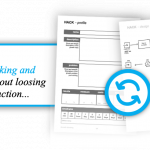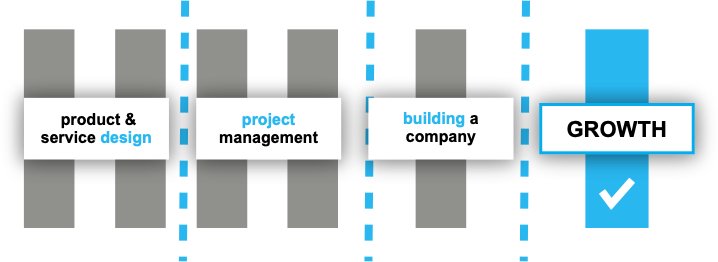So What is growth Thinking?
Most growth hackers lack the structure and systems to take a mind-blowing growth hack and execute it. Even more challenging is scaling it and then putting it into full-scale operations while ensuring its profitability and longevity. This balancing act is over. Growth thinking makes all of that happen quickly, efficiently, and very cost-effectively.
What we will cover:
- Design Thinking And Business Model Canvas
- What Is The Growth Thinking Design System?
- How Does Growth Thinking Work?
- Benefits of using growth thinking
- Growth Thinking Methodology?
- Compare Growth Thinking With Other Methodologies
- How methods like design thinking and business model canvas work with growth thinking
- How to get started with growth thinking
Subscribe for updates
Some key questions about
What is growth thinking
What is growth thinking?

Growth thinking is a design system for growth hackers to quickly and easily take a growth hack from idea to execution and scale in a systemic and visual system that dramatically increases the success rate of growth and growth hacking for organizations.
What are the benefits of growth thinking?

Go from ideas to execution fast, quickly, and at a very low cost.
Think at scale by seeing the bigger picture and all its details simultaneously
Save cost and time but rapidly prototyping the growth hacks without lifting a finger.
Growth Thinking Vs. Design Thinking?

Growth thinking is a design system for growth after you have a product or service in place or building a company whereas design thinking is focused on the product design process.
Design thinking and business model canvas
You ever heard of design thinking or business canvas model, or even lean start. These are all management methodologies designed to help you easily and quickly start, build a business, manage projects, or design a new product or service. These methodologies are designed to help you achieve three things.
- Clarity
- Structure
- Speed
The science behind these methods is where the real secret is — Clarify is achieved through simplification, the structure through the process, and speed through visualization. For example, let’s take the popular Business Canvas Model by Strategizer:

- Clarity – is taking all the moving parts of a business model and putting them into a single perspective to see everyone in one place at once
- Structure – a process of thinking through all the parts of a business model and how they relate and impact each other
- Speed – visual see all parts in one place, where you can quickly make design decisions like what to add, what to remove, what is missing, or what can be improved.
In essence, this is an example of what all management models aim to achieve; they do it in different ways, but they come down to those three simple elements. So which model is best? — there is no real answer to this. It’s all about what works best for you, what actually exists, and how well developing it is. Additionally, how well updated, documented, and supported the model is so many different people can use them.
What is the growth thinking design system?
The growth thinking approach solves those three elements we have outlined above, but its application is unique. It’s for growth, and not just any growth but accelerated growth, in other words, growth hacking. As it stands, there isn’t a single model that helps growth hackers go from growth idea to execution in a snap. This is where growth thinking comes into play.

We will discuss other models later on that deal with growth, but they are narrowly focused on a few things but not the whole process. The entire growth hacking process from start to finish is what growth thinking solves but no other existing model. So how is this model broken down:
- Clarity- the simplification of the growth hacking process from idea to execution without losing sight of the bigger picture and the details at the same time
- Structure – the process enables you to creatively design a growth hack, learn through its 1:5:20 rule system and generate new, better and robust growth hacks quick
- Speed – an utterly visual process allows you to visually see the whole growth hack while seeing the details that make the growth hack-up simultaneously.
The growth thinking design system is an add-on methodology and a stand-alone approach. This means you can use popular methods like design thinking, the business canvas model, The Value Proposition Canvas, and Google Design Sprint. Use the Growth Thinking system with them in a comprehensive manner. Simultaneously, it can be a stand-alone design system where it works without any other methodology. Later we will compare them to different approaches and explain how they connect.
How does growth thinking work?
Growth thinking is a 5 step process that walks you through every detail from a basic idea of converting it into an executable growth hack. In the growth thinking design system, it has the following composition:
- One hack at a time
- Five hacks accumulated
- 20 hacks in total
This is controlled by the 1:5:20 rule learning system at the end of every growth hack, at every fifth hack, and the end is accumulating all 20 growth hacks.

Quick Overview
how does the growth thinking design process work

How to use Growth thinking – This is a step-by-step design process for growth hacking to quickly turn an idea into a growth hack at scale
Basic growth hack 30 minutes
Step 1: Profiling
name, description, costs, ROI, and timing
Step 2: Designing
designing the growth hack in a workflow format
Step 3: Sequencing
detailing the design giving attributes to each element
Step 4: Testing
fail, pass learning system to improve and generate new hacks.
Step 5: Learning
extracting learnings from several hacks to improve and develop new ones
The five-step process is in further details:
- Profiling – name, description, costs, ROI, and timing
- Designing – designing the growth hack in a workflow format
- Sequencing – detailing the design giving attributes to each element
- Testing – fail, pass learning system to improve and generate new hacks.
- Learning – extracting learnings from several hacks to improve and develop new ones
Step 1: Profiling
This is where we capture metadata. The basics that help us outline the growth hack answered the most vital to-level questions like name, description, and expected outcomes.
Step 2: Designing
This is where we put pen to paper and design. We use a nine-syllable workflow-based system in a freestyle format to allow creative ideas to flow without restrictive structures.
Step 3: Sequencing
This is where we detail the design. The sequence allows us to create a specific hierarchical style structure with details based on visual design.
Step 4: Testing
This is where we test the design. This has a structured approach to evaluating in a simple yet powerful what works and does t and, most importantly, what to do next.
Step 5: Learning
This is where we accelerate our growth. We capture improvements, additions, reductions, adjustments, and enhancements, even on success, to develop your next growth hack.
Subscribe for updates
Benefits of using growth thinking
It’s essential to keep in mind what growth thinking solves for. It’s a system that helps growth hackers avoid some of the most common pitfalls they face that eventually lead to failure:
- An excellent growth hack that wasn’t detailed enough
- A great growth hack that isn’t scalable
- A great growth hack that doesn’t have longevity
- A costly growth hack
- A growth hack doesn’t work when executed.
Those are the five reasons why growth hackers fail, and many more, of course, but those are the main reason. So what are the benefits of using growth thinking then:
- Go from ideas to execution fast, quickly, and at a very low cost.
- Think at scale by seeing the bigger picture and all its details simultaneously
- Save cost and time but rapidly prototyping the growth hacks without lifting a finger.
Those three benefits are then supported by a design system that is simple and creative. The main thing here is that creativity is at the center of the process, but this is blended with a structured approach that doesn’t get in the way of the details, nor does it kill the creativity.
Additionally, with the learning system growth hackers can super-charge their growth hacks by quickly finding new growth hacks, improving existing ones, and combining efforts where it makes sense.
What is Growth thinking methodology?
The methodology works like this. You have a spark of an idea for a growth hack; you jump straight into prototyping blank pages using a growth hacking design language. This design language uses nine symbols to map out the design and systematically structure it from an idea to action. Once you’re done, profile it, then sequence the growth hack with the details to execute it. Then put it to the test, and learn from it. The learning transforms into successes you scale or failures that generate new hacks.
This progressive process helps you develop a solid playbook to be used for exponential growth. The learning process, which is in three layers, helps accelerate this. The first layer is learning per each growth hack, the second is learning from every five growth hacks, and the third is learning from all 20 growth hacks. This is achieved by identifying patterns that help, improve, or create better growth hacks.
Compare Growth Thinking with other methodologies
There are four basic types of methods our there classified on their intended outcome. The four approaches are:

Want more information on the comparisons click here

Accelerating growth
How to accelerate and manage exponential growth using growth thinking. Some examples of methods are:
- Pirate Funnel AARRR
- G.R.O.W.S.-process
- T-shaped Growth Hacker
- One Metric That Matters
- North Star Metric

Build a company
How to start and build a company and develop its business model. Some examples of methods are:
- The Business Model Canvas
- The Value Proposition Canvas
- Lean Startup Canvas
- Blitzscaling Canvas Business
- Model Innovation Framework

Managing projects
How to effectively implement and manage a product management model that works. Some examples of methods are:
- Agile
- Scrum
- Waterfall
- Kanban
- PRINCE2

Offering Design
How to optimize and manage product design using approaches like design thinking. Some examples of methods are:
- Design Thinking
- Google Design Sprints
- Lean Startup
- Double Diamond Design
- Kano Model

How methods like design thinking and business model canvas work with growth thinking
As we have discussed, the models help you start and build a company, design a new product or service, or project management but what they don’t do is help you grow. So they work together like lego or peanut butter and jam. Cool, isn’t it. Use the other systems you know to do what they do best and focus on growth thinking.
One of the design systems features that help is the nine symbol workflow system that most of you would be accustomed to already, with a few add-ons and tweaks to make it growth ready.
Growth thinking and Accelerating growth
Growth thinking is a comprehensive growth design system. It isn’t an isolated part of a growth strategy or system but rather a holistic approach. It’s easy to stat very little technical knowledge. It works well with the Pirate Funnel AARRR to accelerate the funnel and the One metric that matters, and the North Star Metric aligns measures.
Growth thinking and Build a company.
Growth thinking, allows you once you have defined your business model, your product design, and how to create value, but taking your starting point and turning it into actual traction/growth. This works well with The Business Model Canvas and The Value Proposition Canvas as a platform to grow from and the Lean Startup Canvas to keep focused on growth.
Growth thinking and Managing projects
Growth thinking kicks in after a project has been complete, mostly for product management and product design. Once you got that in place, it’s time to grow. Using growth thinking with Agile, Scrum, Waterfall, and Kanban allow you to take your final product and grow it.
Growth thinking and Offering Design
Growth thinking helps you take your insights into consumer behavior, offering design and delivery methods by growing them. You can have a great product or service, but it will not work out very well if you cannot grow it. This is where growth thinking works very well with Design Thinking, Google Design Sprints, and Lean Startup.
Subscribe for updates
How to get started with growth thinking
Rounding it all up to What is growth thinking? — The methodology and system are based on the book itself. Your starting point is to buy the book, but here is the best part if you buy the book you’re supported with over $300 in free training support from the quick start, toe basic skill-building, and top 10 secrets to advance your growth thinking skills.
Buy the book click here
See the training click here
Let’s get started! And visit here anytime to recap “What is growth thinking”
———————–
Introduction to growth thinking
growth by design, how to thinking design, and growth hack.
GROWTH BY DESIGN – Most Growth Hackers struggle to get traction for new ideas. A lack of guidance and exact next steps are to blame. Imagine if you could grow a new idea from beginning to end, with a framework to move from idea and action in a fast, simple, and low-cost approach. Actioning ideas with precision isn’t easy; with the growth thinking, science-backed design system built by the top minds in growth hacking, it’s a simple, well structured yet creative system that allows you to find growth.
Growth thinking is a fast, easy, and simple way to prototype growth hacks. This enables growth by visualizing a growth hack in abstract and then detailing them into a systematic approach. This makes it easy to develop and improve growth hacks and generate new, better growth hacks.
Benefits of the growth thinking design methodology — 1. From idea to action – accurately and rapidly turn growth hacking ideas into execution quickly and cost-effectively, 2. Think at scale – quickly and effortlessly find methods to take an abstract growth hack, structure it, scale it, and 3. Save time and money – rapidly prototype your growth hacking ideas saving time and money. This methodology uses a design system that Visualization, Systemize, Optimization, helps Rapid development, and instills Collaboration.
Get your copy of the bestselling book.
“Ready Set Growth Hack:
A beginners guide to growth hacking success”






